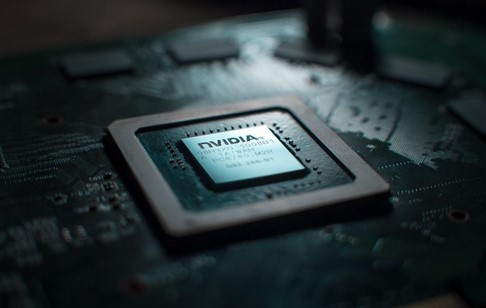Nvidia (NVDA) stepped up to the earnings plate last night. There was a lot of pressure to perform.
Supply issues led to poor performance and a 14% decline at Cisco last week. Snap (SNAP) delivered a negative pre-announced a few days later that led to widespread selling in the tech space.
Neither company indicated any material changes in data center demand or enterprise IT spend. But investors were on alert for weakness fanning out across the rest of the tech industry.

The Nvidia results would shed more light on broad market dynamics as the company remains the industry-leading AI (hardware/software) chip provider. This was an important report for the tech sector.
NVDA posted Q1 earnings of $1.36 per share, 7 cents better than expectations. Revenues increased 46% y/y to $8.29 billion, outpacing estimates of $8.09 billion. The top and bottom lines were not spectacular, but they did soothe some worries.
Datacenter revenues increased 15% quarter-over-quarter 83% year-over-year to $3.75 billion (45% of revenues). Revenue from hyper scale and cloud computing customers more than doubled y/y driven by strong demand for both external and internal workloads.
Customers are increasingly combining the compute and networking products to build out AI factories of data. The marriage between software and hardware improves engagement and deepens the relationship between NVDA and its customers.
The company remains on track to launch its new Data Center CPU chip, Grace, in the first half of 2023. This chip is viewed as the ideal CPU for AI factories. DC will remain a key driver for NVDA. Demand remains strong with no end in sight.
The results in this unit bode well for Marvell (MRVL) which derives 42% of its revenues from DC and will report earnings after the close.
The networking business remains highly supply-constrained. Demand is strong but the product lines require a lot of components, transceivers, connectors, cables etc. This creates logistical issues as the company needs to procure numerous products. NVDA does see these issues improving sequentially through the remainder of the year.
Gaming was a different story.
Gaming revenues were up 6% q/q and 31% y/y to $3.62 billion (43% of revenues). NVDA stated end demand remained solid though mixed by region. While the Americas remained robust, the company saw weakness in parts of Europe related to the Ukraine War and China due to lockdowns.

The company expects an ongoing impact from the Russia/China situation as it prepares for architectural transitions later in the year. Nvidia expects a sequential decline in the teens for gaming as the headwinds persist.
The decline in crypto is another headwind for the sector. Nvidia has never been able to quantify the impact of crypto mining, but it expects a diminishing contribution going forward.
One positive was that the company is seeing channel inventory normalize for components in consoles.
Professional Visualization declined -3% q/q to $622 million, falling short of the $647 million street expectations. The weakness was attributed to lower desktop revenues. Overall demand remains strong as enterprises continue to build out employees’ remote office infrastructure.
Automotive and Robotics declined for the second straight quarter, falling 10% from the prior-year period to $138 million. It did see a sequential rise of 10% as supply chains started to improve. This would be a positive for semiconductor companies with heavy exposure to the sector like NXP Semiconductors (NXPI) and On Semiconductors (ON).
Nvidia kicks off a major product cycle in auto while customers ramp up production in Q2 and beyond. A combination of a new product cycle and supply chain improvement could lead to a strong boost in the coming quarters. This will help offset a portion of the gaming weakness.
Looking at the company’s profitability, gross margin improved by 90 basis points from the prior year. Nvidia believes it can offset rising costs and supply chain pressures which will allow it to maintain gross margins in 2022.
NVDA remains on track to grow non-operating expenses by 20% this year. A significant amount of costs will be front-end loaded. This could weigh on margins next quarter. But expenses decline aggressively as new product launches roll out in 2H22.
The company did say it was slowing down hiring to integrate new employees. That is a subtle hint that the jobs market could be cooling.
Looking ahead to Q2, NVDA expects revenue to come in around $8.1 billion at the mid-point which is lower than the $8.4 billion street expectations.
Guidance assumes an estimated impact of $500 million relating to Russia and China. Gaming will be impacted the most as sales will decline by $400 million. Data Center will lose approximately $100 million due to the Russia fallout. Russia represented approximately 2% of the company’s revenues historically with gaming being a larger percentage.
Overall, the results from Nvidia highlighted some consumer weaknesses as the outlook for gaming was the key drag on the stock. It does appear most of the softness is due to the company withdrawing from Russia and the China lockdowns.
The lockdowns in China also represented a drag on the supply chain which is capping top-line results. Analysts will lower estimates due to the lost Russian business. China remains a wild card, but it will translate into a tailwind when the country starts to re-open.
Nvidia is launching multiple new GPU, CPU, DPU, and SoC products over the coming quarters. The ramp-up in new products should overlap improved supply chain performance. The next-gen H100 ramps in Q3, further solidifying DC/AI leadership.
The new product launches could come at a perfect time if we see supply chain issues ease. The market would have preferred to see some signs that the China COVID-related lockdowns improved. Nvidia reiterated expectations of a sequential improvement in supply chains. This bodes well for NVDA given its product cycle.
Overall, the story from Nvidia will do little to change the narrative around tech. The question investors will ask is whether this has been priced into stocks.
Shares of NVDA are down 42% YTD compared to a 16% decline in the SPY and a 26% decline in the VanEck Semiconductor ETF (SMH).
The stock remains expensive as it trades at 25x forward earnings and 16x Price-to-Sales. But there is a reason for the premium as the company is the class in AI, an area that will continue to see growth.
Customers are increasingly combining the company’s compute and networking product to build what is essentially a modern AI factory with data as the raw material input and intelligence as the output.
The deeper integration by customers, the launch of best-in-class new products, and easing of supply chain constraints should allow NVDA to weather the storm and come out stronger on the other end.
The stock may see further volatility moving forward, but this pullback is a gift for longer-term investors as this will be one of the best companies over the next decade.



